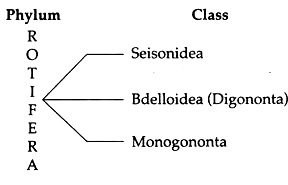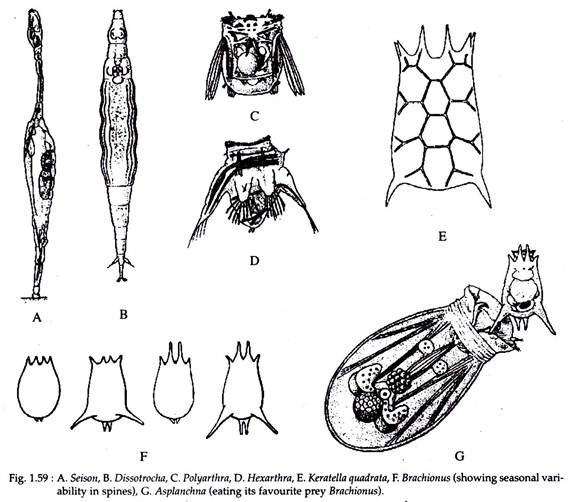In this article we will discuss about Phylum Rotifera:- 1. Introduction to Phylum Rotifera 2. Diagnostic Features of Phylum Rotifera 3. Scheme of Classification 4. Systematic Resume.
Introduction to Phylum Rotifera:
The animals commonly known as rotifers constitute the phylum Rotifera. They along with protozoans and small crustaceans (Cyclops, Daphnia, Cypris etc.) comprise the fresh water zooplankton and are important in nutrient recycling in aquatic system.
Rotifers are found in fresh and marine water as well as in moist terrestrial habitat among mosses and lichens. Most rotifers are solitary, free swimming or crawling animals, but there are sessile as well as a few colonial species which are in fact aggregation of solitary individuals. Rotifers have a body that is usually transparent, although some may appear green, brown, red or orange due to colouration of the digestive tract.
ADVERTISEMENTS:
Etymology:
Latin: Rota, a wheel; ferra, to carry.
Diagnostic Features of Phylum Rotifera:
i. Body elongated, transparent relatively cylindrical and bilaterally symmetrical.
ii. Most rotifers measure 0.1 to 1 mm in length (a little longer than ciliated protozoans).
ADVERTISEMENTS:
iii. Body more than two cell layer thick with tissues and organs.
iv. The anterior end contains a crown of cilia called the corona, often organized into two wheel-like ciliary organs from which the name of the group is derived.
v. Epidermis, with a fixed small number of nuclei, is frequently stiffened into a distinctive armor, called a lorica. Cuticle is generally absent.
vi. Body not segmented.
ADVERTISEMENTS:
vii. Body cavity is pseudocoelomic.
viii. Mouth typically ventral that opens directly or indirectly into the pharynx, in the latter case via a ciliated buccal tube.
ix. The pharynx or mastax (a distinguishing feature of the phylum), which is oral or elongated and highly muscular, bears seven large interconnected, projecting pieces or trophi. The mastax is used in capturing and triturating food, while the trophi is used for raptorial or suspension feeding.
x. Absence of circulatory system and respiratory organs.
xi. Rotifers are ammonotelic animals and have two typical protonephridia in the pseudocoel.
xii. The nervous system consists of a brain, comprising of a dorsal ganglionic mass lying over the mastax which gives rise to a number of nerves that extend to different parts of the body.
xiii. Rotifers are either dioecious or parthenogenetic females. The dioecious species, have males that are always smaller than the females and their sex organs are often degenerated.
xiv. Cleavage spiral and development is direct. Nuclear division get completed early in development and never occurs again.
Scheme of Classification of Phylum Rotifera:
About 1800 species have been described and most have a wide spread distribution. The phylum rotifera has been subdivided into three classes by Ruppert and Barnes (1994).
Systematic Resume of Phylum Rotifera:
Class Seisonidea:
i. Elongated body with a long neck.
ii. Presence of a much reduced corona.
iii. Mastax prominent.
iv. Little sexual dimorphism with fully developed males and females being equally common in the population.
v. Ovaries lack vitellaria.
vi. Marine rotifers, that live on the gills of crustaceans — Nebalia and some isopods.
Example:
Seison (Fig. 1.59A).
Class Bdelloidea (Digononta):
i. Microscopic and cylindrical body.
ii. The members possess a characteristic “two-wheeled” corona.
iii. Anterior end retractile.
iv. Mastax adapted for grinding with one pair of flattened trophi.
v. Foot often with more than two toes and with spurs.
vi. Presence of more than two pedal glands.
vii. Germovitellaria are paired in females.
viii. Males absent, whole population comprises of parthenogenetic females.
ix. They possess the ability to pass into a state of anabiosis, when they become dried out and can withstand extremes of temperature + 40° to -200°C.
x. Swimming (freshwater) or creeping forms.
Examples:
Philodina, Embata, Rotaria, Adineta, Dissotrocha (Fig. 1.59B).
Class Monogononta:
i. Mastax, if adapted for grinding is not like bdelloids.
ii. Foot reduced or with two toes.
iii. Presence of two pedal glands.
iv. Males are very small in size and with one testis.
v. Females with one germovitellarium.
vi. Parthenogenesis common, but periodic sexual reproduction does occur involving the dwarf, non-feeding males.
vii. Swimming (fresh water) or sessil forms.
Examples Brachionus (Fig. 1.59F), Keratella (Fig. 1.59E), Filinia, Monommata, Asplanchna (carnivorous) (Fig. 1.59G), Polyarthra (Fig. 1.59C), Hexarthra (Fig. 1.59D), Testudinella, Collotheca, Stephanoceros.

